Get Started with Prompt Builder
Learning Objectives
In this project, you’ll:
- Create and test a prompt template that includes merge fields.
- Associate a prompt template with a text field for field generation.
Streamline Content Generation
Prompt Builder gives your organization an easy way to tap into the power of generative AI. It helps you combine existing data with some well-crafted instructions to create prompt templates. In a nutshell, prompt templates are used to create prompts, the messages sent to large language models (LLMs) in order to generate content.
Prompt templates are special because they include placeholders for specific details about customers, products, cases, and more. Each time a prompt template is used, it merges the data to create a unique, personalized prompt, which results in a personalized response. And since prompt templates are reusable, they’re a key part of a scalable AI implementation. For a more in-depth explanation of prompts and prompt templates, check out Prompt Fundamentals.
In this project you get hands-on by creating a prompt template, and then use it to get actual generated responses from an LLM. Specifically, you’ll focus on a scenario everyone is familiar with: customer support cases. In an effort to boost productivity and customer satisfaction, you want to use generative AI to summarize the details of a case in about 100 words. This enables agents to get up to speed quickly and makes it easier to identify cases that deserve special attention.
Sign Up for a Trial Org with Einstein Generative AI
To complete this project, you need a special, limited-time custom playground that contains Einstein AI and our sample data.
- If you haven't already, click the I can receive a password email checkbox in the beginning of the unit.
- Click Create Playground.
- Follow the prompts.
- Make note of your org's expiration date and complete this badge before then.
Create a Field Generation Prompt Template
In this project, you want a case summary to appear in a text field on the record. To save a little time, Team Trailhead has already created a field named Quick Summary and added it to the page layout. At this point there’s nothing special about it, but let’s change that! You start by creating a prompt template.
- If you don’t already have your Einstein AI-enabled trial org open, scroll down to the Challenge section and click Launch to open it.
- Click
 and click Setup. The Setup page opens in a new tab.
and click Setup. The Setup page opens in a new tab.
- In the Quick Find box, enter
einstein setup, then click Einstein Setup.
- Verify that the Turn on Einstein toggle is set to the On position. If it is already On, then toggle it Off and then back On again.

- Refresh your browser window to reveal new admin settings now that Einstein is enabled.
- In the Quick Find box, enter
prompt, then click Prompt Builder.
- Click New Prompt Template.
- For Prompt Template Type, select Field Generation.
- For Prompt Template Name, enter
Quick Summary.
- Keep the API Name:
Quick_Summary.
- For Template Description, enter
A short summary of case details.
- For Object, find and select Case.
- For Object Field, find and select Quick Summary.
- Click Next.
Great, you now have the start of a prompt template. It’s time to build it by writing some clear instructions that describe what you want from the LLM. As you learn in the Prompt Fundamentals badge, there are several things you can add to get better results. In this example you include the overall goal, size limits, and some guardrails.
Writing a good prompt is somewhat of an art form, so for this project we give you a prompt that we know works well.
- Paste the following text into the Prompt | Insert Resource field.
Summarize the concatenation of the contents of the comment bodies of COMMENTS along with the text from SUBJECT, the case priority which is PRIORITY, and the case type which is TYPE. Keep the response to a single short paragraph. - Click Save.
- From the Models list, choose OpenAI GPT 4 Omni Mini.
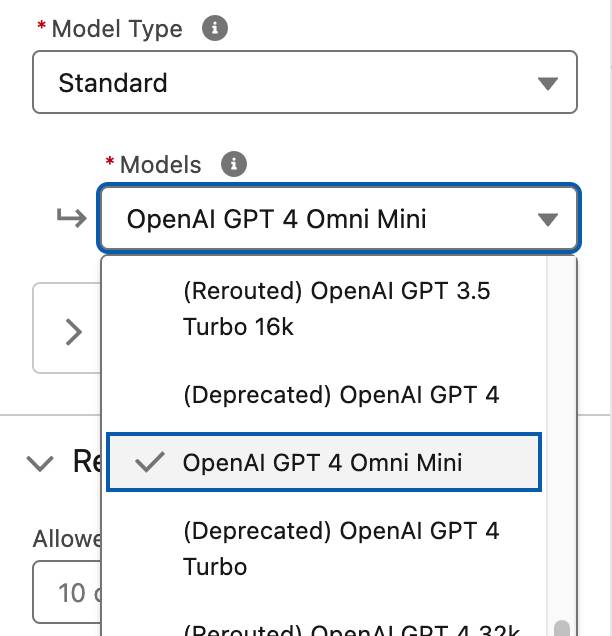
There are several models to choose from in your Einstein AI-enabled org, and OpenAI GPT 4 Mini produces some great results.
This sample text includes a few placeholders in all caps for things like case priority. Let’s replace those with actual merge fields so the LLM can create a tailored response for a variety of situations.
- In the prompt sample text, place the mouse cursor in front of the word PRIORITY.
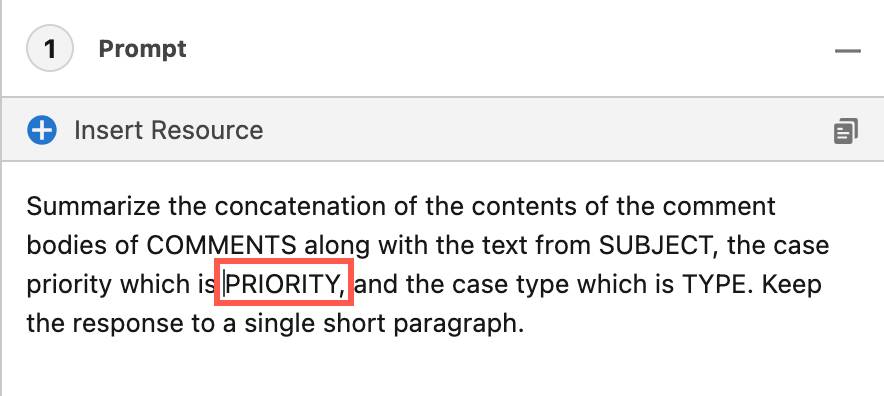
- Click + Insert Resource to open the list of resources.
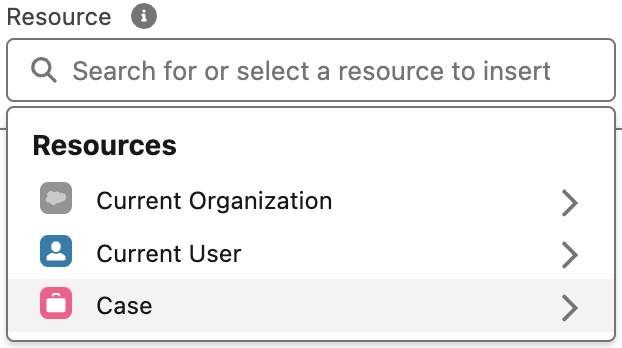
- Click Case, then click Priority.
A merge field is inserted as blue text.
- Delete PRIORITY to leave behind just the merge field. It should now look like this:
…the case priority which is Input:Case.Priority, and the case type…
Next, you repeat the process to replace the COMMENTS, SUBJECT, and TYPE text placeholders.
- Place the mouse cursor in front of COMMENTS.
- Click in the Resource box. Select Case, then click CaseComments.
Note: Notice the colorful text, it indicates that this is a related list. (The text color may vary depending on your browser settings.)
- Delete COMMENTS to leave behind just the merge field. It should now look like this:
Summarize the concatenation of the contents of the comment bodies of RelatedList: Case.CaseComments along with the text…
- Place the mouse cursor in front of SUBJECT.
- Click in the Resource box. Select Case, then click Subject.
- Delete SUBJECT to leave behind just the merge field.
- And finally, place the mouse cursor in front of TYPE.
- Click in the Resource box. Select Case, then click Case Type.
- Delete TYPE to leave behind just the merge field.
- Click Save.
With merge fields in place, your prompt template should look like this:
Summarize the concatenation of the contents of the comment bodies of RelatedList: Case.CaseComments along with the text from Input:Case.Subject, the case priority which is Input:Case.Priority, and the case type which is Input:Case.Type.
Keep the response to a single short paragraph.
It’s just that easy to ground your prompt in real data. Now that your prompt template includes merge fields and good instructions, it’s time to test it out. Prompt Builder makes it easy to preview your prompt template using actual data. All you need is a sample record to draw from.
- Click Preview, then click Inputs to expand the Inputs box.
- In the Related Record box, find and select case 00001002.
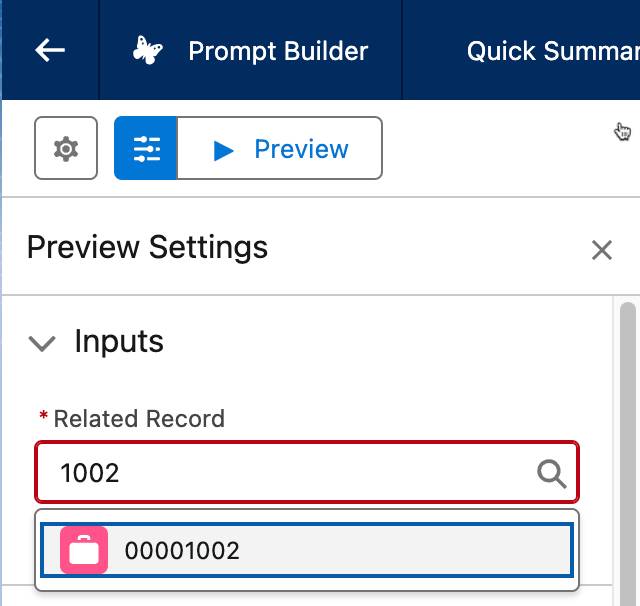
- Click Preview.
- Click Activate.
This is the moment you’ve been waiting for! Your instructions have been sent to the LLM, and in response you get a generated summary of the case in just a few sentences in the Generated Response field. Yours may appear a little different than the examples in this project. That’s OK, it’s normal for LLMs to respond to the same prompt in more than one way.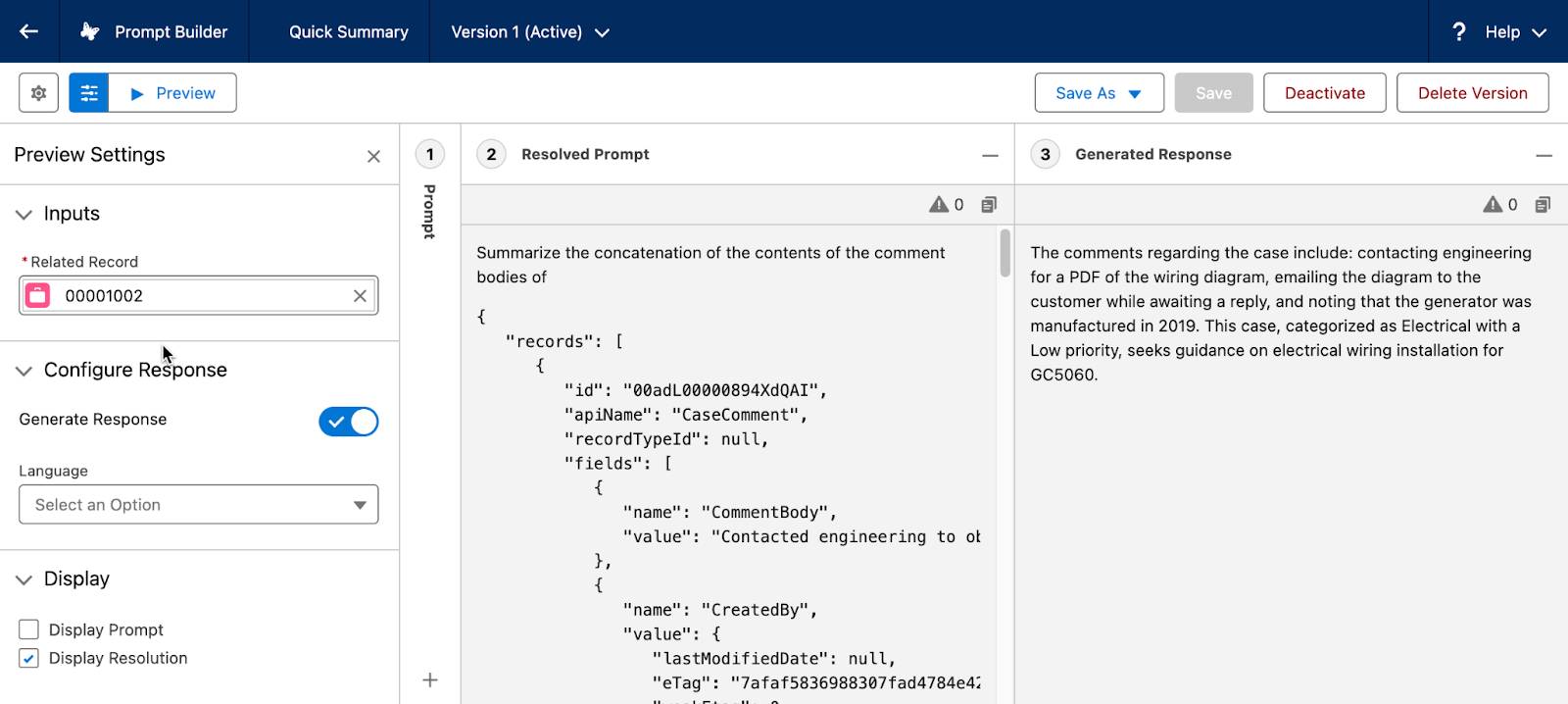
Enable Dynamic Forms for Cases
Your prompt template is ready to go. The last step is to update the page layout so that your customer support team can use the new prompt template.
- While still on the Prompt Builder page, verify that you’ve clicked Activate.
- Close the Setup tab to return to the Sales app.
- In the Navigation Bar, click Cases. (You may need to click More to find it.)
- Click the down arrow next to Recently Viewed, and select All Open Cases.
- Click case number 00001002.
- Click
 and click Edit Page.
and click Edit Page.
- In the Details section, select the Record Detail component [1].
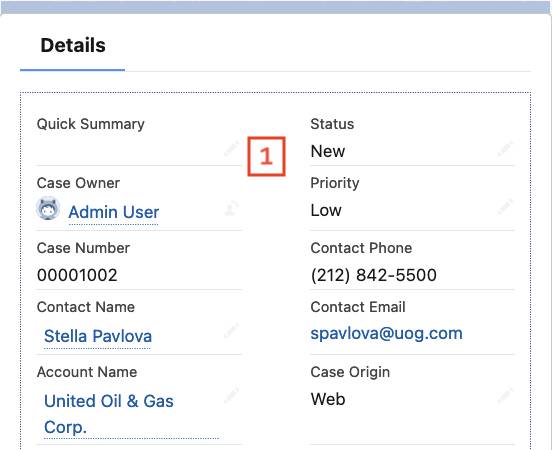
- With the Record Detail selected, click Upgrade Now in the properties pane to upgrade to Dynamic Forms.
- Click Next.
- Select the Case Layout page layout.
- Click Finish.
- In the Case Information section, click the Quick Summary field.
- For Prompt Template, find and select Quick Summary.
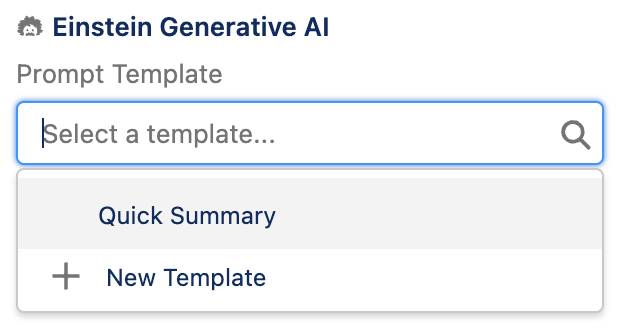
- Click Save and then Activate.
- Click the Assign as Org Default button (you may need to scroll down a bit).
- Click Next and then Save.
- Click the back arrow in the upper left to leave the Lightning App Builder.
Excellent, the Quick Summary field is ready to use Einstein Generative AI. You can tell because the edit button has a little star next to the pencil now.

Let’s try it out.
- Click
 on the Quick Summary field.
on the Quick Summary field.
- Click
 on the right of the field.
on the right of the field.
This automatically opens up the Einstein overlay and uses your prompt template to start a new conversation. In a moment Einstein will suggest a case summary. Again, yours may be a little different than ours:
Here is what I came up with
The comments regarding the case include the following actions: contacting engineering for a PDF of the wiring diagram, emailing the diagram to the customer while awaiting a reply, and noting that the generator was manufactured in 2019. This case, which has a low priority and pertains to electrical issues, seeks guidance on the electrical wiring installation for GC5060.
In the Einstein overlay panel, it looks like this:
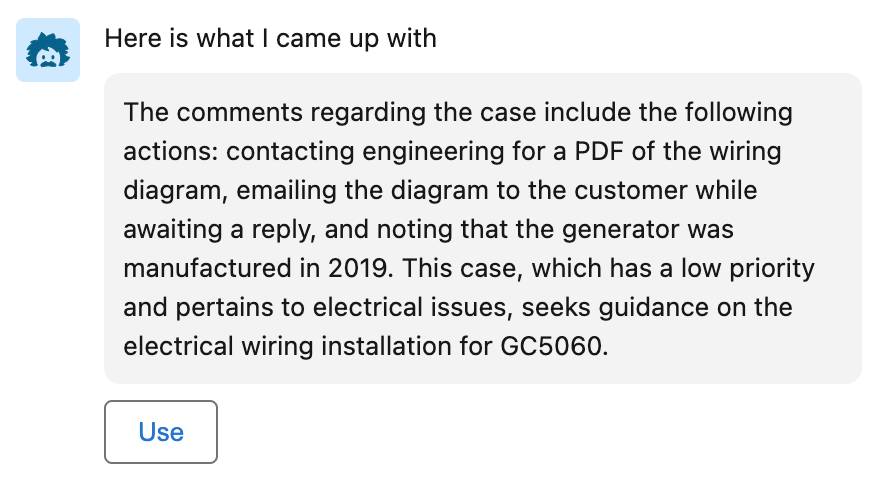
This gives your users a chance to review the summary, and even continue the conversation with Einstein to work together on a revised version. For this example, you just accept the first suggestion.
- Click Use. (There should be a Use button in the Einstein overlay. If there isn’t, just refresh the page and do steps 1 & 2 again.)
- Click the X to close the Einstein overlay.
Notice that the Quick Summary field is filled in.
- Click Save.
With just a few clicks, your users can access the power of Einstein Generative AI to quickly create useful content so that they can focus on more important things. The conversational nature of Einstein lets your users refine the generated content in real time, and they can always tweak it after it’s placed into the field.
Great job creating such a helpful prompt template. Have fun experimenting in the Prompt Builder to discover other ways to automate text generation for your organization.
